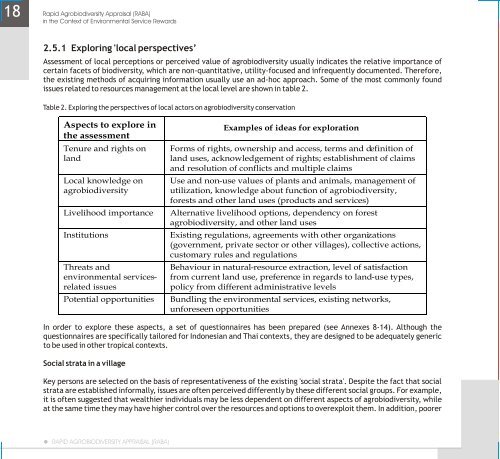Rapid Agrobiodiversity Appraisal (RABA) - Are you looking for one ...
Rapid Agrobiodiversity Appraisal (RABA) - Are you looking for one ...
Rapid Agrobiodiversity Appraisal (RABA) - Are you looking for one ...
Create successful ePaper yourself
Turn your PDF publications into a flip-book with our unique Google optimized e-Paper software.
18<br />
<strong>Rapid</strong> <strong>Agrobiodiversity</strong> <strong>Appraisal</strong> (<strong>RABA</strong>)<br />
in the Context of Environmental Service Rewards<br />
2.5.1 Exploring 'local perspectives’<br />
Assessment of local perceptions or perceived value of agrobiodiversity usually indicates the relative importance of<br />
certain facets of biodiversity, which are non-quantitative, utility-focused and infrequently documented. There<strong>for</strong>e,<br />
the existing methods of acquiring in<strong>for</strong>mation usually use an ad-hoc approach. Some of the most commonly found<br />
issues related to resources management at the local level are shown in table 2.<br />
Table 2. Exploring the perspectives of local actors on agrobiodiversity conservation<br />
Aspects to explore in<br />
the assessment<br />
Tenure and rights on<br />
land<br />
Local knowledge on<br />
agrobiodiversity<br />
In order to explore these aspects, a set of questionnaires has been prepared (see Annexes 8-14). Although the<br />
questionnaires are specifically tailored <strong>for</strong> Ind<strong>one</strong>sian and Thai contexts, they are designed to be adequately generic<br />
to be used in other tropical contexts.<br />
Social strata in a village<br />
Key persons are selected on the basis of representativeness of the existing 'social strata'. Despite the fact that social<br />
strata are established in<strong>for</strong>mally, issues are often perceived differently by these different social groups. For example,<br />
it is often suggested that wealthier individuals may be less dependent on different aspects of agrobiodiversity, while<br />
at the same time they may have higher control over the resources and options to overexploit them. In addition, poorer<br />
RAPID AGROBIODIVERSITY APPRAISAL (<strong>RABA</strong>)<br />
Examples of ideas <strong>for</strong> exploration<br />
Forms of rights, ownership and access, terms and definition of<br />
land uses, acknowledgement of rights; establishment of claims<br />
and resolution of conflicts and multiple claims<br />
Use and non-use values of plants and animals, management of<br />
utilization, knowledge about function of agrobiodiversity,<br />
<strong>for</strong>ests and other land uses (products and services)<br />
Livelihood importance Alternative livelihood options, dependency on <strong>for</strong>est<br />
agrobiodiversity, and other land uses<br />
Institutions Existing regulations, agreements with other organizations<br />
(government, private sector or other villages), collective actions,<br />
customary rules and regulations<br />
Threats and<br />
environmental servicesrelated<br />
issues<br />
Behaviour in natural-resource extraction, level of satisfaction<br />
from current land use, preference in regards to land-use types,<br />
policy from different administrative levels<br />
Potential opportunities Bundling the environmental services, existing networks,<br />
un<strong>for</strong>eseen opportunities

















![CynefinFramework final [Read-Only]](https://img.yumpu.com/19017304/1/190x135/cynefinframework-final-read-only.jpg?quality=85)